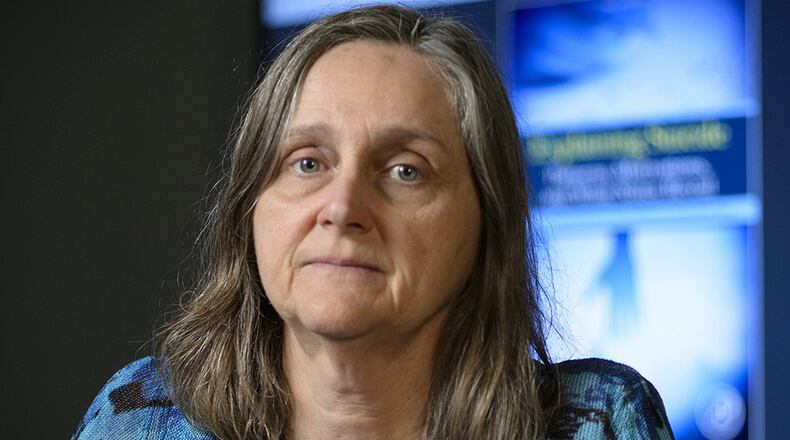Suicides now surpass the number of deaths from motor vehicle crashes in the United States with more than 44,000 suicides recorded in 2015, or a rate of about 13 per 100,000 Americans, according to the most recent data from the Centers for Disease Control and Prevention.
Gallup Poll: Ohio ranks low for healthy eating https://t.co/B1dFVRAUmK
— Randy Tucker (@Rtucker612) May 3, 2017
The average, age-adjusted suicide rate in the U.S. jumped about 30 percent from 2000 to 2015 after decreasing steadily from the mid-1980s through the 1990s, according to the CDC.
Ohio has mirrored the national trend, with the suicide rate climbing from 9.5 per 100,000 people in 2000 to 13.1 per 100,000 in 2015 — although the state rate pulled back to 12.8 per 100,000 last year.
Experts say a variety of factors, including drugs and chronic disease, have contributed to rising suicide rates, making it difficult to determine an overriding cause.
But evidence suggests the lingering affect of the Great Recession, which decimated retirement and savings accounts, displaced many workers from good-paying jobs and led to foreclosure and family crisis, may be largely responsible for the rise in suicides among the group most at risk — middle-aged white men.
RELATED: Many Ohioans still struggling despite low unemployment
The pace of suicides accelerated after 2006, the year before the recession began, and middle-aged adults, mainly white men, accounted for the largest share of suicides (56 percent) from 1999-2010, according to CDC data analyzed by this newspaper.
“For the most part, these are people whose lives were OK before, then all of sudden their lives are spinning out of control,” said Cheryl Meyer, a Wright State University psychology professor. “They’ve lost their job, they’re getting thrown out of their house because they can’t pay the mortgage anymore. When you’re life is spiraling out of control, it’s very difficult to get out of that tunnel vision and imagine any alternative.”
RELATED:Governor's recession warning for Ohio may be overstated
Meyer reviewed 1,280 suicide cases before 2010 in the region — including 179 in which the victims left notes or letters — for a book she co-authored: “Explaining Suicide: Patterns, Motivations and What Notes Reveal.”
The book includes excerpts from the victims, of whom 87 percent were men, and 91 percent were Caucasian, Meyer said.
One man, whose financial investments had depleted his savings, wrote: “I have no regrets only that I could not finish my life.”
In another case, a middle-aged man who had lost his high-paying sales job and been unemployed for more than two years wrote: “Had a good life it’s my time to go.”
RELATED:2016 Ohio job growth worst since 2009
The victims had few other problems in their lives before they were hit with the cascading consequences of the economic downturn, Meyer said, indicating they were simply overwhelmed and emotionally unprepared to face such adversity.
“I certainly think that you could argue, and it has been argued, that these are people who had a lot of power and privilege, and when they lost that power and privilege, they didn’t have the resilience that other groups did,” she said. “Maybe that is why we’re seeing this group having the highest percentage” of suicides.
While middle-age white men may be most at risk, suicide is a public health crisis affecting people of all ages, races, and ethnicities struggling to come to grips with despair and depression, similar to veterans and active-duty soldiers who have double the suicide rate of non-veterans, according to Kathy Platoni, a Dayton-area clinical psychologist and retired U.S. Army colonel who served as a counselor in the Iraq War and War in Afghanistan.
Credit: Kara Driscoll
Credit: Kara Driscoll
Platoni, who also works as a police psychologist for the Dayton Police Department’s SWAT team — responding to crisis situations, including officer-involved shootings and suicide interventions — attributes the sharp increase in suicides in part to a lack of mental health resources.
Platoni said many people with suicidal thoughts struggle to find the proper therapists, medication and support they need in state’s like Ohio, where the mental-halth system is strapped for funding, leading many to lose hope. And more and more people are finding themselves in need of such services in an increasingly aging and isolated society, she said.
RELATED: Local mental health services strained
“As people age, they begin to lose their loved ones, lose the people that sustain them, just like soldiers in war,” Platoni said. “After sustaining loss, after loss, after loss, you throw in the towel. You stop caring. What’s happening today is that people no longer have the same sense of community and belonging that we did in traditional families years ago.”
Credit: Kara Driscoll
Credit: Kara Driscoll
Platoni said the era of social media era in which people of all ages and colors spend hours online without directly interacting with another person has increased social isolation and suicidal behavior.
In fact, such behavior has become commonplace on social media sites, prompting Facebook CEO Mark Zuckerberg to announce last week he would hire 3,000 additional workers just to monitor videos and other posts after a wave of livestreaming videos showing suicides, murder and other violent acts on Facebook.
“I just want to ask these people when did your life become so meaningless,” Platoni said. “Life is a gift. It may not feel that way every day, but it is. Sadly, some people have to re-learn that in a big way.”
About the Author


